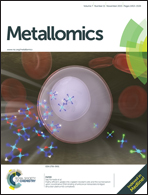Gene-specific regulation of hepatic selenoprotein expression by interleukin-6†
Abstract
Sepsis is a severe inflammatory disease resulting in excessive production of pro-inflammatory cytokines including interleukin-6 (IL-6), causing oxidative stress, tissue damage and organ dysfunction. Health benefits have been observed upon selenium (Se) supplementation in severe sepsis. Selenium is incorporated into selenoproteins implicated in anti-oxidative defence, thyroid hormone metabolism and immunoregulation. Selenium metabolism is controlled by hepatocytes synthesizing and secreting the Se transporter selenoprotein P (SePP). The circulating SePP declines in sepsis causing low serum Se levels. Dysregulation of the hepatic selenoenzyme deiodinase type 1 (DIO1) potentially contributes to the low T3 (thyroid hormone) syndrome observed in severe diseases. We hypothesized that IL-6 affects hepatic selenoprotein biosynthesis directly. Testing human hepatocytes in culture, IL-6 reduced the concentrations of SePP mRNA and secreted SePP in a dose-dependent manner. In parallel, expression of DIO1 declined at the mRNA, protein and enzyme activity level. The effects of IL-6 on glutathione peroxidase (GPX) expression were isozyme-specific; GPX1 remained unaffected, while transcript concentrations of GPX2 increased and those of GPX4 decreased. This pattern of IL-6-dependent effects was mirrored in reporter gene experiments with SePP, DIO1, GPX1, and GPX2 promoter constructs pointing to direct transcriptional effects of IL-6. The redirection of hepatic selenoprotein biosynthesis by IL-6 may represent a central regulatory circuit responsible for the decline of serum Se and low T3 concentrations in sepsis. Accordingly, therapeutic IL-6 targeting may be effective for improving the Se and thyroid hormone status, adjuvant Se supplementation success and survival in sepsis.


 Please wait while we load your content...
Please wait while we load your content...